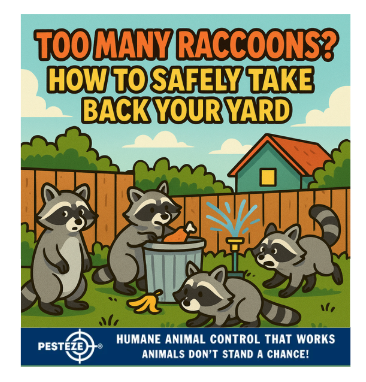TOO MANY RACCOONS? HOW TO SAFELY TAKE BACK YOUR YARD

TOO MANY RACCOONS? HOW TO SAFELY TAKE BACK YOUR YARD
SUMMARY
Raccoons may look cute, but an overpopulation can cause serious problems—raided trash cans, garden damage, attic invasions, and even health risks. This guide explains how to recognize when raccoons have become a problem and outlines safe, humane strategies to manage their growing numbers.
FEATURES
-
Spot the warning signs: Learn how to tell if raccoons are becoming a problem.
-
Remove temptations: Secure trash, pet food, and other attractants.
-
Deter without harm: Use motion-activated sprinklers, lights, and repellents.
-
Block their entry: Seal attics, chimneys, and crawl spaces effectively.
-
Call in the pros: Wildlife experts can handle infestations legally and safely.
-
Get neighbors involved: Community-wide action reduces raccoon issues.
GUIDE DESCRIPTION
Raccoons are smart, resourceful, and increasingly common in both cities and suburbs. While a few sightings may not be cause for concern, a sudden spike in raccoon activity can spell trouble. An overpopulation of raccoons can lead to overturned garbage bins, chewed wires in attics, damaged gardens, and the spread of diseases like rabies or leptospirosis.
The first step in regaining control is to spot the warning signs. If you notice raccoons appearing frequently during the day, droppings around your property, or repeated attempts to access your attic or trash bins, it’s a clear sign the population nearby is too high.
Next, focus on removing temptations. Raccoons are opportunistic feeders—if food is easy to find, they’ll keep coming back. Invest in raccoon-proof garbage cans with locking lids, feed pets indoors, and bring bird feeders in at night. Securing compost piles is also essential.
To keep raccoons away without harming them, rely on humane deterrents. Motion-activated sprinklers and lights startle raccoons, while ultrasonic devices can make your yard less inviting. Scent-based repellents like ammonia or predator urine sprays add another layer of protection.
Protect your home by blocking entry points. Seal off attic vents, chimneys, crawl spaces, and sheds with heavy-duty mesh or flashing. Because raccoons can dig and climb, reinforce fences by burying the base a few inches underground and trimming trees near your roofline.
If you’re dealing with a serious infestation, it’s time to call in the pros. Licensed wildlife control specialists can safely and legally trap or relocate raccoons while ensuring compliance with local laws. Handling raccoons yourself is risky and not recommended.
Finally, remember that raccoon overpopulation is a community issue. Work with your neighbors to secure trash bins, reduce attractants, and report infestations. A coordinated effort helps manage raccoon numbers more effectively than individual actions alone.
By combining prevention, deterrents, and professional assistance, you can take back your yard while respecting the wildlife around you.
- Saneeth Thota


Comments 0